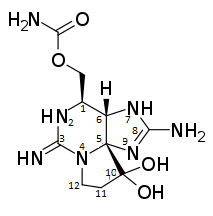 Structure of dcSTX
| |||
| |||
| Names | |||
|---|---|---|---|
| IUPAC name
(3aS,4R,10aS)-2,6-diamino-4-(hydroxymethyl)-3a,4,8,9-tetrahydro-3H-pyrrolo[1,2-c]purine-10,10-diol
| |||
| Identifiers | |||
3D model (JSmol)
|
|||
| ChemSpider | |||
| KEGG | |||
PubChem CID
|
|||
| UNII | |||
CompTox Dashboard (EPA)
|
|||
| |||
| |||
| Properties | |||
| C9H16N6O3 | |||
| Molar mass | 256.26 g/mol | ||
Except where otherwise noted, data are given for materials in their standard state (at 25 °C [77 °F], 100 kPa).
| |||
Decarbamoylsaxitoxin, abbreviated as dcSTX, is a neurotoxin which is naturally produced in dinoflagellate. DcSTX is one of the many analogues of saxitoxin (STX).

Saxitoxin is a tricyclic alkaloid compound, which has multiple structural related neurotoxins. One of those related neurotoxins is neosaxitoxin (NSTX) in which the nitrogen at position 2 is not bound to a hydrogen, but to a hydroxyl group. Another toxic analogue of saxitoxin is gonyautoxin (GTX). The difference between GTX and STX is that on the carbon at position 11, a hydrogensulfate is bound.
Between dcSTX, NSTX and GTX, dcSTX is the one which varies most from saxitoxin. In dcSTX there is a double bond between carbons 2 and 3, while there is a single bond in STX. This also results in that the double-bonded N to carbon number 3 in STX, is a single bound NH2 in dcSTX. Another difference between decarbamoylsaxitoxin and saxitoxin is that the amino-carbonyl-oxy-methyl group at position 1 in STX, is only a CH2OH group in dcSTX.
Even though there are slight differences between all saxitoxin-related compounds, all those saxitoxins are neurotoxins which affect the sodium channels. When in contact with one of the saxitoxins it can cause a severe illness, which is known as paralytic shellfish poisoning (PSP).

